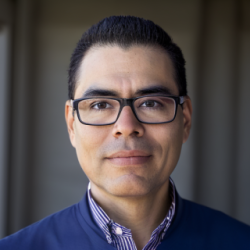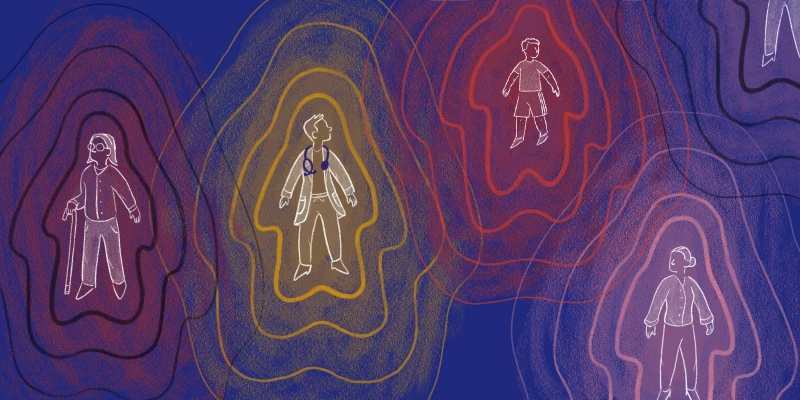Life may never be the same after a major heart attack or having stents placed. Some of the patients Rose Pavlakos, PharmD, sees may enter the hospital never having taken medication for their heart, and leave with five or more prescribed. They’re overwhelmed by a new diagnosis and don’t know the “why” for their treatment. Pavlakos and her team at the UCSF Cardiovascular Care and Prevention Center meet these patients where they’re at, helping them afford and access their medications and providing education, reconciliation, and more.
These clinically complex patients may only see a cardiologist every three to six months or even once a year. “The cool thing about me being involved is that I follow up with them weekly or biweekly until they reach their goal, that way the cardiologist can focus on their job which is diagnosing medical issues,” Pavlakos shared. Pharmacists can fill in gaps, helping doctors optimize drug therapy regimens and helping patients meet therapeutic goals faster. “It’s impossible to be able to fully assess the patient, prescribe the appropriate medications, and also verify that all their medications are safe in a 15-minute appointment,” she said.
Kirsten Tolstrup, MD, associate chief of cardiology at UCSF, has worked with Pavlakos for the past six years. Only seeing patients in clinic once a week, Dr. Tolstrup doesn’t have the bandwidth to titrate and follow patients with difficult-to-control hypertension, so she depends on the expertise of Pavlakos and her team to support her patients. “They’re really skilled. Patients love them and they’re very personable and take their time,” Dr. Tolstrup said. She’s grateful for that thoroughness, as she knows that she’s not a medication specialist, trusting that instead to Pavlakos: “Rose is better than me at treating hypertension. I trust her and her team.”
When patients can’t afford expensive medications like novel anticoagulants, Dr. Pavlakos and her team find solutions, like vouchers, to reduce the burden of high co-pays.
“These services really help the patient see that we are a team that cares about them. The team approach is very important — no one can work in a silo,” Dr. Tolstrup emphasized.
And collaborating with pharmacists reflects well on physicians. “When the patients are happy they give good reviews because they perceive that I was the one that sent them to the pharmacist. For physicians, it’s a win-win,” she said.
To be able to implement this collaborative team approach between prescribers and pharmacists requires leadership and institutional support. Dr. Tolstrup recommends having metrics to follow the impact, which helps obtain funding. And to build a new program you need a champion. “The only challenge is pharmacists not having the bandwidth to do everything we’d like them to do. We would like to expand and hire more pharmacists. Other institutions need to learn about what [Pavlakos] did and how she’s been able to contribute to decreased hospital admission rates,” she said.
In order to gain the greatest benefit from working with a pharmacist, physicians need to understand the pharmacist's role.
“The biggest suggestion I would give to any team trying to implement this is to find the appropriately trained pharmacist,” Pavlakos advised. "Pharmacists have the same primary training, but then after pharmacy school, we have opportunities to explore residencies in different areas. Some pharmacists are highly trained in the hospital or community setting. If you’re a physician looking for a pharmacist to join your practice I would recommend connecting with a pharmacy school or pharmacist group."
As pharmacists’ scope of practice evolves, challenges persist for the profession. Pavlakos feels fortunate to practice in California where pharmacists can prescribe under a collaborative practice agreement. Pharmacists without that agreement cannot make crucial medication changes and decisions.
“Nationally, we are not viewed as providers when we have doctorate degrees. Until that happens we can’t even bill for our services. It’s a big reason why pharmacists have trouble implementing themselves in clinics,” Pavlakos lamented.
Despite this barrier, pharmacists may be positively impacting patient outcomes. In one BMC Endocrine Disorders study, pharmacist-managed care of patients with Type 2 diabetes was associated with significantly improved HbA1c than standard care alone.
Pavlakos has had to get creative with how she bills her care. “I think clinics are hesitant to hire pharmacists because it’s hard to pay them, so finding the funding is really a struggle. I’ve figured out a way to bill under facility fees in my clinic. Other pharmacists have found a way to collaborate with HMOs,” she shared. Pavlakos is frustrated with needing workarounds to do her job. “Our national organizations are working to fix this. And doctors support us. I can guarantee any of the doctors I work with would show up in court to support pharmacists getting provider status,” she said.
Misconceptions about pharmacy may hinder progress and contribute to the underutilization of pharmacists. “So many people for so long thought pharmacists sat and counted pills,” Pavlakos said. “That’s never been our job. I’m a medication specialist and that’s what pharmacists should be ideally doing. Yes, we can help with prior authorization but that’s really the job of the pharmacy technician.” Pavlakos recognizes that interdisciplinary education in medical schools and pharmacy schools can help counter this misconception. Working at a teaching hospital like UCSF gives her the opportunity to teach students of different credentials. “That’s vital in getting them to use each other as resources in their future careers,” she said.
It is not a matter of one clinician being better than another. “Our approaches to care are different and sometimes because I’m seeing them more often they open up to me,” Pavlakos said. She argues that pharmacists are probably “the most accessible health team member.” One recent patient encounter highlights this: “I had a patient who hadn’t been taking his medications for three weeks because he was depressed and overwhelmed by a new diagnosis. That is the point of everyone being involved.”
Image by invincible_bulldog / GettyImages







